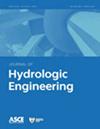基于海绵城市地下水利用理念的下沉式广场水循环系统
IF 1.9
4区 工程技术
Q2 ENGINEERING, CIVIL
引用次数: 0
摘要
在下沉式广场中采用自然、低影响的地表水和地下水管理方式,对城市生态发展具有重要意义。为了实现水的储存、净化和循环利用,本研究基于地下水和地表水的转化和组合,研究了一个下沉式广场的水循环系统。采用地下连续墙、钢筋混凝土墙、建筑主体结构、相邻支撑结构、主体结构底部防水层组成联合止水帷幕体系。基于研究区地层资料和参数,利用FEFLOW 7.5软件建立了地下水位三维模型,将现场抽水试验的实际地下水位监测数据与模拟数据进行对比,验证了模型的准确性,并计算了下沉式广场的水量变化。通过现场试验和数值模型计算得出帷幕系统的低渗透性,证明下沉式广场的抽水活动对广场外地下水位的影响极小。在此基础上,科学合理地设计了抽渗井和水质水量观测井。结合雨水、排水、景观、铺装等设施,实现水的净化和循环控制。根据本研究设计的循环系统,下沉式广场年水循环利用能力可达6万m3以上,雨水中总悬浮物(TSS)、化学需氧量(COD)、总氮(TN)、总磷(TP)等指标平均降低15%以上。下沉式广场区域形成一个小海绵体,首次利用地下水蓄水实现水循环、经济效益和生态功能。该方法可用于类似地质环境的下沉式广场水循环和生态建设。本文章由计算机程序翻译,如有差异,请以英文原文为准。
Water Circulation System of a Sunken Plaza Based on the Concept of a Sponge City Utilizing Groundwater
The use of a natural and low-impact way of managing surface water and groundwater in a sunken plaza is meaningful for urban ecological development. To achieve water storage, purification, and recycling, this study investigated a water circulation system in a sunken plaza based on the groundwater and surface water transformation and combination. A joint water-stop curtain system was constructed with underground continuous walls, RC wall, building main structure, adjacent support structure, and waterproof stratum at the bottom of the main structure. On the basis of the stratum data and parameters of the study area, a three-dimensional (3D) groundwater model was built using FEFLOW 7.5 comparing the actual groundwater level monitoring data from the field pumping test with the simulation data, the accuracy of the model was verified, and the water volume change of the sunken plaza was calculated. The low permeability of the curtain system calculated by a field test and the numerical model proved that the pumping activities in the sunken plaza had extremely low impact on the groundwater level outside the plaza. On the basis of this result, the pumping and seepage wells and water quality and quantity observation wells were designed scientifically and rationally. The purification and circulation control of water were realized in combination with rainwater, drainage, landscape, paving, and other facilities. According to the circulation system designed in this study, the annual water recycling capacity of the sunken plaza can reach more than 60,000 m3, and the total suspended solids (TSS), chemical oxygen demand (COD), total nitrogen (TN), and total phosphorus (TP) indicators in the rainwater can be reduced by more than 15% on average. The sunken plaza area forms a small spongy body that realizes water circulation, economic benefits, and ecological functions for the first time using groundwater storage. The developed method can be used for the water circulation and ecological construction of sunken plazas with similar geological environments.
求助全文
通过发布文献求助,成功后即可免费获取论文全文。
去求助
来源期刊

Journal of Hydrologic Engineering
工程技术-工程:土木
CiteScore
4.60
自引率
4.20%
发文量
83
审稿时长
4.5 months
期刊介绍:
The Journal of Hydrologic Engineering disseminates information on the development of new hydrologic methods, theories, and applications to current engineering problems. The journal publishes papers on analytical, numerical, and experimental methods for the investigation and modeling of hydrological processes.
 求助内容:
求助内容: 应助结果提醒方式:
应助结果提醒方式:


